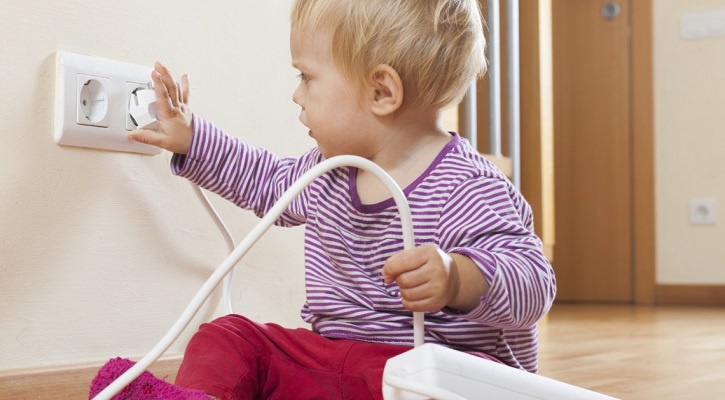
Make Your Home Childproofing
- Womenscorner Desk
- June 21, 2020
Home accidents in all over the world are among the top causes of childhood injuries and deaths. Childproofing your home can reduce the risk. Home accidents include burns, falls, electrocution, drowning, poisoning, choking, and head injuries.
Burns:
- Replace traditional flame candles with battery-operated candles.
- Use knob covers on stoves. Turn the handles on your pots and pans toward the back of the stove so your child cannot pull a hot pan down on top of his or herself.
- Install childproof faucet and shower spout covers in your bathroom and kitchen to prevent hot water burns. Lower the temperature on your hot water heater.
- Keep matches and lighters out of reach.
- Don’t leave burning cigarettes around children.
- Install and regularly check smoke detectors. Dispose of hot ashes outside in a fireproof bucket.
- Install a fireplace screen around your fireplace.
Falls:
Place baby gates across stairways or entries to rooms that could pose unsafe exposure. This includes the kitchen, bathroom, garage, laundry room, or basement. Choose gates that can be fastened to the wall with durable hardware. Add doorknob covers to your outside doors to prevent your child from falling off a deck, balcony, or the stairs.
Secure windows with barrier netting or protective window guards. Window guards should prevent the window from opening more than 4 inches. Window screens are flimsy and can be pushed out. Choose window guards you can easily “undo” in the event of a fire.Use barrier netting around decks and balconies.
Use padded bumpers to cover sharp corners on furniture and your fireplace hearth to soften the injury of a fall. Anchor tall, heavy furniture or appliances against the wall or to the floor with brackets and bolts to keep it from tipping over onto your child. Poisoning: Lock cabinets, closets, and doors to rooms, drawers, and other storage areas containing common household poisons. These include cleaning supplies, medicine, laundry detergent, and dishwasher pods. Install carbon monoxide detectors throughout your home. Change the batteries twice a year when you change your smoke alarm batteries. Replace the detector if it’s not working properly.
Drowning:
- Drain water from sinks and tubs, child pools. Install a childproof lock on your toilet. Drain your larger, outdoor pool at the end of the season.
- Install doorknob covers on doors leading to the bathrooms. Secure your pool or hot tub with a sturdy cover designed for the product (not a light tarp).
- Install a four-foot fence around the perimeter of an outdoor pool or hot tub to protect your child and neighborhood children. Lock the gate.
- Add a secure lock to the door or doors leading to an outside pool. Push-up bars on sliding glass doors are not effective and can be lifted by a young child.
- Use a floating pool alarm to an outdoor pool or hot tub. This device sends out a warning sound when something or someone enters the water.
Choking: Keep choking hazards, such as small toys, coins, clothing, buttons and other choking hazards away from your baby or young child.
Burns: Children suffer from both mild and severe burns from fires started by candles, scalding water, burning cigarettes, hot stoves, a fireplace, and home fires.
Falls: A fall down the stairs, or from a balcony, deck, or window can lead to broken bones and serious or deadly head (or spinal) injuries.
Poisoning: Many poisons look child friendly, including colorful pods used for laundry and dishwashers. Colorful medicines also look appealing to young children. Carbon monoxide is odorless and invisible.
Drowning: A child can drown in 2 inches of water. Drowning is a danger if your child is left alone near the kitchen sink, bathtub, or toilet, as well as pools and hot
tubs.
Choking: Young children are at risk of choking while eating or when putting a non-food object in their mouths. If your child is choking, you may not hear gagging or coughing. You may notice your child is unable to speak or make noise, may have loud or no breathing, blue lips, or fall unconscious.
Electrocution: Something as small as an electrical outlet can cause death if your child sticks a metal object into the outlet.
Strangulation and suffocation: Many household items can cause suffocation, including plastic bags used for groceries, trash, or dry cleaning. Children can suffocate by climbing into a toy box with a lid or into an unplugged freezer or refrigerator. Strangulation can occur with everyday things, including the cords on window blinds and shades, strings or ribbons used in clothing, necklaces, elastic headbands, and a mobile that hangs above a crib.
Injuries from guns and knives: Deaths and injuries from accidental gunshots and stabbings are common. These can occur when guns and knives haven’t been properly removed or stored away from a child’s reach.
Source : Google





